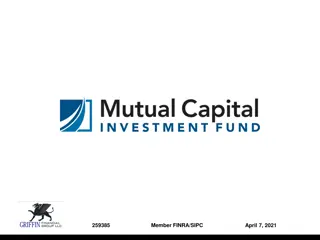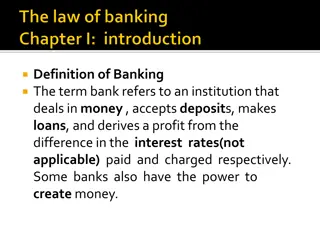Importance of Capital Regulation in Banking
Capital regulation plays a crucial role in protecting the stability of individual banks by imposing constraints on leverage and ensuring a balance between debt and equity. It acts as a safety net, absorbing losses and preventing taxpayer bailouts. Originating from the Basel Agreement of 1988, capital requirements have evolved to enhance bank profitability and mitigate economic externalities. However, challenges such as procyclicality and asset price fluctuations necessitate innovative solutions like countercyclical buffers.
Download Presentation

Please find below an Image/Link to download the presentation.
The content on the website is provided AS IS for your information and personal use only. It may not be sold, licensed, or shared on other websites without obtaining consent from the author.If you encounter any issues during the download, it is possible that the publisher has removed the file from their server.
You are allowed to download the files provided on this website for personal or commercial use, subject to the condition that they are used lawfully. All files are the property of their respective owners.
The content on the website is provided AS IS for your information and personal use only. It may not be sold, licensed, or shared on other websites without obtaining consent from the author.
E N D
Presentation Transcript
Protects stability of individual bank Not a requirement to hold or reserve funds. Affects balance between debt and equity. Requirement to hold equity acts as a constraint on leverage (limit on bank borrowing) Equity can absorb losses and stands between bank and potential taxpayer bailout A traditional means to ensure solvency.
Date back to only the Basel Agreement of 1988 Were originally sold as a form of deregulation
Movement toward capital regulation began in 1983 Background is 1982 Mexican default and third world debt crisis Banks did not hold capital against loans to third world countries
Lower capital held in European banks permitted more borrowing Wanted international agreement to keep even playing field 1988 Basel Accord
Replaced older reserve requirements that actually did require banks to reserve funds Replacing reserves with capital regulation would improve bank profitability Capital requirements were consistent with the deregulatory movement toward reliance on market forces rather than government intervention. Relied on profit-driven equity investments in private markets, not reserves with central bank.
Stands between bank and potential bailout Can limit economic externalities associated with excessive borrowing Can be supplied from retained earnings through provisioning However, experience has shown many potential problems associated with capital regulation
Markets will supply capital in a boom and withhold capital in a downturn. Can exacerbate economic instability Changes in asset prices increase the procyclicality of capital regulation - especially when you must mark to market. This is particularly true for risk-adjusted capital Possible solutions -- countercyclical capital buffers, capital requirements based on stressed asset prices
Capital arbitrage Capital risk adjustments can be manipulated by banks Lower quality capital cannot be used to absorb losses Activities migrate to unregulated shadow banks with no capital requirements
Is capital primarily attracted by profits? If so, does that increase incentives to take risk? Can a regulatory tool that depends on market responses to profitability ensure soundness? Will larger capital requirements for banks ensure balanced economic growth?
Capital can be an effective tool for individual bank solvency Can it be extended to ensure stability of the overall financial system? Increased capital charges to deter risky activities, excessive size, interconnectedness?
Additional capital charges for large/interconnected institutions. Additional capital charges for especially risky activities (Volcker Rule) Macro-prudential regulation in addition to capital regulation. Capital requirements for non-bank financial entities ( shadow banks ).
Tier 1 (high quality capital) requirement increased from 2 percent to 7 percent. Counter-cyclical capital buffer of an additional 2.5 percent reserved during booms. Absolute leverage limits set in addition to risk-adjusted capital requirements.
Stressed capital charges -- based on asset prices from a period of economic stress. Unspecified additional capital charges for large and interconnected organizations. Will not be fully phased in until 2019.
Reserves can be created and extinguished as needed on a countercyclical basis. Reserves held with the Fed are not marked to market; they retain their face value. Reserves maintain investor confidence























